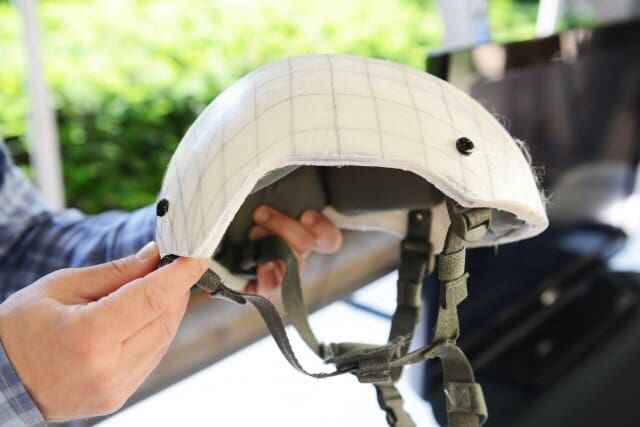The Close Combat Lethality Task Force recently held a Tech Day at the Pentagon. A wide variety of equipment was on hand. U.S. Army Natick Soldier Research, Development and Engineering Center researchers displayed a next generation helmet called the ACH Gen II: UHMWPE.

US Army photo by C. Todd Lopez
Essentially, it’s based on the second generation Army Combat Helmet, except that they’ve improved how the ultra-high-molecular-weight polyethylene (UHMWPE) used in the helmet is processed during molding. The ACH Gen II already offered a 22% weight reduction over the original ACH but can only stand up to 9mm and Frag threats.
The ACH Gen II: UHMWPE weighs 2.5 pounds for the shell, and an estimated 3.5 pounds final weight, but provides the same level of protection as the Integrated Head Protection System, which has just begun fielding. However, it does so without having to add a ballistic appliqué for rifle rounds like IHPS. Consider that an IHPS weighs about 5 lbs with the appliqué fitted. For a rifle threat-level Helmet, that’s a significant improvement.
Natick continues to develop Helmet technologies with a goal of offering rifle level protection in the weight of current Frag protection (ACH).
Tags: Natick Soldier Research Development and Engineering Center


Interesting. 10 years ago, Natick complained about lack of coverage and industry not meeting ACH crush specification and 9mm specification- which hindered SOF in being able to field a more capable, lighter weight, better fragmentation helmet.
10 years later, their way of thinking has changed slightly- based on this picture. Way to be ahead of the curve!
No more backface requirement either.
For awhile SOF ditched helmet covers because it was easier to paint. More recently they are back in style.
Lessons relearned about shine and sound.
Everyone learns (or relearns) all the time.
Those aren’t lessons learned, those are changes based on the battlefield changing and TTP’s changing. Until guys started doing offset walk ins, nobody cared about the shine on their helmet. When TTP’s changed, the need for the helmet cover arose. And truth be told, the first gen of new helmets came with a cover.
What I’m talking about is Natick hindering SOF because of legacy requirements that weren’t based on anything tangible other that “this is what our current helmet does”. Now, 10 years later, they are presenting a helmet that is only possible because SOF fielded an industry developed helmet with less coverage, that didn’t meet the crush requirement, and didn’t meet the 9mm BFD requirement. Had it not been for SOF coming off of the requirement, and industry building to a new specification, the new Natick helmet would look drastically different.
It would probably looked more like Dark Helmet from Space Balls if it wasn’t for SOF.
SOF SOF SOF SOF SOF Haaaaaa
Is it a good idea to get rid of the BFD/crush requirement?
I thought blunt trauma head injuries were a big deal recently.
I’ll agree the coverage argument is bullshit though. If the coverage is that important enough, you can always make attachments a la the FAST or airframe.
The BFD and crush requirements went away when units started fielding new lightweight helmets in 2008.
If you want a lighter helmet, you make concessions. That is the part Natick didn’t understand. They were scared to bless off on something that was “different” and “lesser performing”. The new wave of helmets aren’t “lesser” performing, they just perform differently because the real requirement was to get weight off of the guys heads. Not too many soldiers in Iraq faced a 9mm pistol as their main threat- fragmentation was more of the issue.
Now that high cut helmets are the norm, 10 years later Natick is able to present this without the General freaking out- “oh my, it’s not enough coverage- we’re going to get people killed!”
Natick, who is chartered to be out front, had to be dragged to the front by both SOF and industry.
Fail.
Don’t know how extensive your experience is and not to say that it’s not true (TTP is important) but this is what was shared with me from 3rd, 5th, 7th groups as well as 3/75 and Reg’t.
The first deployments into Afghanistan had huge movement to objectives and folks were sporting painted helmets.
I suspect it’s some of both.
Do they plan on fielding the helmet in the picture within… say 5 yrs?
If they’re looking at SOF only, I cannot see why they can’t field sooner. If the helmet pictured is more than a proof of concept, I can’t imagine it being that difficult to field a smaller requirement like the teams in the near term.
Force wide, I could see a 5 year window being more realistic, if not doing something similar with the Marines and doing an expedited fielding for forward deployers.
This is just a random dude’s guess; that has some experience in government contracting, and rapid fielding, etc.